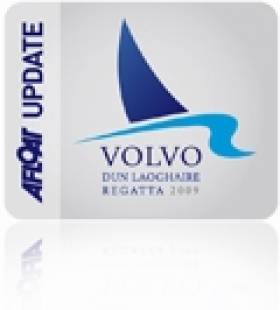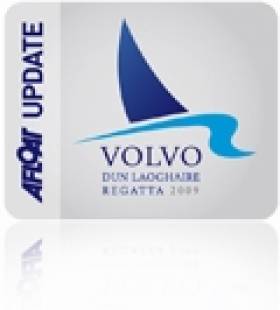Displaying items by tag: Dun Laoghaire Regatta
Are Dublin Bay Buoy Wind Speed Readings Correct?
#dlregatta – There's white water across Dublin Bay this morning and as sailors will tell you it's enough to blow dogs off chains. Curiously though the wind speed readings from the Dublin Bay Buoy in the middle of five Volvo Dun Laoghaire Regatta races areas only show a fraction of that. It's led to comment on twitter (see below) that calls into question the accuracy of the current readings of the Dublin Bay buoy. Twitter users have been able to live track live weather updates from a buoy in the middle of Dublin Bay since last May. The @DublinBayBuoy account is tweeting at regular intervals with the average wind speed, gust speed and wind direction on the bay, as well as the current wave height and water temperature. And it's all been made possible thanks to an array of sensors installed on the buoy by the Commissioners of Irish Lights to record live meteorological ocean data. The Twitter bot should come in especially handy at this weekend's 409-boat regatta among some of the Irish Seas top sailing talent but only if the information is accurate.
Anyone experience this weather and wave during racing today?? @dlregatta @sailingindublin https://t.co/HPjE7HDwjn
— Damien Byrne (@db2909) July 9, 2015
The conditions certainly don't match @DublinBayBuoy readings... https://t.co/ecIPEKVegZ
— Dun Laoghaire Marina (@DLMarina_Dublin) July 10, 2015
#dlregatta – With the Kinsale ICRA Nats/Sovereigns Trophy 2015 very successfully concluded last weekend, and a classic Dun Laoghaire to Dingle Race put stylishly in place before that, the feeling of another sailing summer busily in progress is all-pervasive. But while the image projected may well be one of stately progress by the cruiser-racer fleets along the Irish coast, taking in an offshore race here and a regatta there with much leisurely cruising in between, the reality is usually otherwise. For those boats doing significant segments of the programme, it's a case of fitting chosen events into the usual hectic early summer life of work and family commitments and exams and everything else, with the re-location of boats to the next venue being a hurried task undertaken by delivery crews.
Next week sees the mid-season peak of the sailing summer, with the four day Volvo Dun Laoghaire Regatta 2015 in Dublin Bay from Thursday July 9th to Sunday July 12th. In a way it is an amalgamation of all that has has already occurred in this year's season, together with new elements to make it a unique sailfest which celebrates the fact that the citizens of Ireland's capital city and their guests can be conveniently sailing and racing within a very short distance of the heart of town. W M Nixon sets the scene
In the dozen or so years since its inception, the biennial Volvo Dun Laoghaire Regatta has settled itself firmly into the sailing scene as an exceptionally varied event in terms of the boats and classes taking part. There are five regular cruiser-racer classes, plus an offshore division, fourteen one design keelboat classes, and nine dinghy classes. And although there are contenders from Ireland's north coast and from the Cork area and south coast too, together with one gallant entry from Galway, it is essentially an Irish Sea Sailfest, though with a remarkably strong Scottish presence.
However, it was on the coast of Wales at 8.0pm last night that this sailing celebration began, with an ISORA Race starting in Holyhead and heading for Dun Laoghaire to set this large and complex programme into action towards a culmination on Dublin Bay in eight days time with the conclusion of VDLR2015.
2015 marks the Bicentennial of the Royal Dee YC, which was founded in 1815 on the Cheshire shores of the River Dee estuary where northwest England marches with northeast Wales. Originally the Dee Yacht Club (and founded, it's said, a month or two before the Royal Yacht Squadron came into being in the south of England, making the RDYC the second-oldest Royal yacht club in England after the Royal Thames), the Cheshire club became the Royal Dee YC in 1847.
Although the great prosperity of Liverpool in the 19th century saw the club's fleet of substantial yachts gathered in the Dee and then increasingly in the Mersey, by the late 1900s it was looking to the Menai Straits area as the focus of its keelboat events. As well, the completion of Holyhead breakwater in 1873 added a new and important harbour to its list of possible big boat sailing locations, and there was an increase in the number of cross-channel "matches" which the Royal Dee and the Royal Mersey, in conjunction with the Dublin Bay clubs, had already been running for some years.

A Royal Alfred YC cross-channel match from Dublin Bay to Holyhead gets under way in 1888. Cross-channel links were strong in the latter half of the 19th Century, and with the new breakwater completed at Holyhead in 1873, a new venue was available both for the Irish clubs and those on the other side such as the Royal Dee and the Royal Mersey

The bicentenary logo of the Royal Dee YC. In 1815, this club on the Cheshire coast was founded shortly before the Royal Yacht Squadron in the souh of England, whose Bicentennial is being celebrated at the end of July.

Dun Laoghaire saw its first regatta staged in 1828, and participation by yachts from the northwest of England and North Wales was regularly recorded. This is the Royal St George YC regatta of 1871.
So when we say that the Royal Dee has always been a stalwart of offshore racing in the Irish Sea, we're not referring to a story spanning only the 20th and 21st Centuries. On the contrary, it goes well back into the 1800s. And now, with the revival of keelboat sailing in the Mersey with several of Liverpool's myriad docks being given over to recreational use, we have in a sense come full circle with enthusiastic Dublin Bay support of the Bicentennial celebrations reflecting sailing links which go back almost 200 years
The Lyver Trophy is the Royal Dee's premier offshore challenge, and this year it is special, as it's a fully-accredited RORC event counting for points in the annual championship, and a highlight of the ISORA Programme 2015. It's start scheduled for yesterday evening in Holyhead will see the fleet – mostly regular ISORA contenders – sail a course of at least a hundred miles before finishing in Dun Laoghaire. Then as VDLR 2015 gets under way, races in it, combined with the Lyver Trophy results, will count as part of a series towards finding an overall winner of the RDYC Bicentennial Trophy.
Only entrants in the Lyver Trophy race are eligible, and for that race itself – which can be followed on the Averycrest Yellowbrick Tracker - the favourite has to be the Shanahan family's J/109 Ruth, still buoyed up by her great victory in the Dun Laoghaire to Dingle Race three weeks ago.

Back in The Bay – the Shanahan family's J/109 Ruth will be back in her home waters of Dublin Bay after winning the Dun Laoghaire to Dingle Race and completing the Lyver Trophy Race from Holyhead which started last night. Photo: David O'Brien
At the other end of the size scale, the VDLR2015 Dublin Bay programme includes several dinghy classes, and the biggest fleet will be mustered by the International GP 14s, who have designated the racing in Dublin Bay as their Leinster Championship. In an interview with Sailing on Saturday in March, VDLR Chairman Tim Goodbody emphasised that, overall, the event should be seen as a regatta rather than a championship, and for most boats that's just what it will be. But the GP 14s with their great esprit de corps have always done things their own way, and with their compact boat size – albeit comprising a large fleet of dinghies – they reckon they can get in a proper championship while sharing in the fun of the event.
 The brothers John and Donal McGuinness of Moville Sailing Club in Donegal are expected to be among the pace-setters in the GP 14 class with their superb Alistair Duffin-built boat. Photo: W M Nixon
The brothers John and Donal McGuinness of Moville Sailing Club in Donegal are expected to be among the pace-setters in the GP 14 class with their superb Alistair Duffin-built boat. Photo: W M Nixon

The GP 14 Ulsters 2015 were recently won on Lough Erne by Shane MacCarthy & Damian Bracken of Greystones
As to who is favourite, the McGuinness brothers – Donal and John - from Moville in Donegal, with their top-of-the-line Duffin boat built in Northern Ireland, have to be in the reckoning after being top Irish at last year's Worlds on Strangford Lough, but there's fresh blood in the fleet with the newest class developing at Youghal, while this year's recent Ulster Championship on Lough Erne was won by the Greystones duo of Shane MacCarthy and Damian Bracken.
The dozen and more boats coming south from Scotland, most of them substantial cruiser-racers, are testimony to a growing trend in sailing on Europe's Atlantic seaboard. Given a choice of venues, your average yachtie on this long coastline will incline to head south if at all possible. Other things being equal, it's reckoned the further south you go the warmer it is likely to be. And from the upper reaches of the Firth of Clyde, there are times when Dublin Bay might seem like the distant and sunny Mediterranean.
Maybe so, but we'd caution that much depends on the moods and location of that all-powerful weather determinant, the northern Polar Jetstream. In July, so long as it's well clear of Ireland -whether to the north or the south - we will have glorious high summer, and that occurred for the previous VDLR back in 2013, where the photos speak for themselves.
So we hope for the best in looking forward to welcoming a fleet of around 415 boats to Dun Laoghaire between July 9th and 12th, with all four of our in-harbour yacht clubs extending the hand of hospitality in a regatta tradition that goes right back to 1828. But while heritage and ceremonial are all very well in their place, it's the prospect of good sport which energises the participants and their sailing, and with several major contests already logged in 2015, what can we expect on the leaderboards next week?
At the top of the tree, Class 0 has formidable competition, including former Scottish champion Jonathan Anderson racing his XP38i Roxstar against the Royal Cork's Conor Phelan with the Ker 37 Jump Juice, which was one of the best performers in last year's ICRA Nationals at the same venue, and this year again became a force to be reckoned with as the breeze sharpened in the four day Kinsale ICRA Nats 2015/Sovereigns Cup a week ago.
 Freshly squeezed – her storming finish to last weekend's final race of the ICRA Nats/Sovereigns Cup at Kinsale makes Conor Phelan's Ker 37 Jump Juice one of the top contenders in the VDLR2015. Photo: David O'Brien
Freshly squeezed – her storming finish to last weekend's final race of the ICRA Nats/Sovereigns Cup at Kinsale makes Conor Phelan's Ker 37 Jump Juice one of the top contenders in the VDLR2015. Photo: David O'Brien
With a win in the final race, Jump Juice came in second to seasoned campaigner George Sisk's class overall winning Farr 42 WOW (RIYC), the pair of them in turn displacing the early leader, lightweight flyer Mills 36 Crazy Horse (ICRA Commodore Nobby Reilly & Alan Chambers, HYC) down to third in the final day's racing, so Crazy Horse will be hoping for a return of lighter breezes when racing starts next Thursday on Dublin Bay.
In the previous Volvo Dun Laoghaire Regatta in 2013, the most successful boat in was Nigel Biggs' much-modified Humphreys Half Tonner Checkmate XV, but this year the Biggs team is racing as Checkmate Sailing with the newest boat in the fleet, the Mark Mills-designed American-built C & C 30 OD Checkmate XVI. She may be only 30ft LOA, but she's such a hot piece of work with so many go-fast bells and whistles that she has a rating of 1.140 to put her in Class 0.
The oldest boat in the cruiser-racer fleets will be found in Class 3, where the 44ft Huff of Arklow is making an historic return to Dublin Bay racing. Originally built in 1951 by Jack Tyrrell of Arklow to a design by dinghy genius Uffa Fox, Huff is so-called because her concept is reckoned three-quarters Uffa Fox and one quarter Douglas Heard. The latter was the founding President of the Irish Dinghy Racing Association in 1946, and he later went onto to become Commodore of the Royal St George YC and a noted cruising and offshore racing enthusiast with this unusual boat, which is like a very enlarged Fying Fifteen with a lid – in fact, with her 30ft-plus waterline, she was described as a Flying Thirty. In recent years she has undergone a total restoration with Cremyll Keelboats near Plymouth in Devon, and Dominic Bridgeman of the Cremyll group will be racing her with trainee crews in her old home waters of Dublin Bay.

The Flying Thirty Huff of Arklow racing off Dublin Bay while under Douglas Heard's ownership in the 1950s. Built by Tyrrell's of Arklow in 1951, the hugely innovative Huff has recently had a major restoration, and will be making her return to Dublin Bay to take part in VDLR2015.
Among the newer boats on the bay, the 2013 champion Checkmate XV is still very much in the picture, but now she's owned by Howth's Dave Cullen, and took second overall in class in the Kinsale series a week ago. In Dun Laoghaire next week, she's with other Half Tonners at the lower end of the Class 2 rating band on 0.944, almost 200 rating points below the new Biggs boat. Class 2 also includes the Division 3 winner at Kinsale, Richard Colwell & Ronan Cobbe's Corby 25 Fusion (HYC) which bested VDLR 205 Chairman's Sigma 33 White Mischief in a real duel after they went into the final day's racing equal on points, while another Kinsale success story in the Class 2 lineup is Paddy Kyne's X302 Maximus from Howth, overall winner of the Portcullis Trophy for top ECHO boat.

Dave Cullen's modified Half Tonner Checkmate XV will be looking to take the top slot on Dublin Bay after being runner-up in Kinsale. Photo: David O'Brien
In between the two Checkmates on ratings, we find most of the cruiser-racer fleet, with Class 1 shaping up some interesting competition between the likes of Paul O'Higgins Corby 33 Rockabill (RIYC), Kenneth Rumball skippering the Irish National Sailing School's Reflex 38 Lynx, and two very sharp First 35s, Prima Luce (Burke, Lemass & Flynn, NYC & RIYC) and another former Scottish Series champion, John Corson (Clyde Cr C) with Salamander XXI.
This year's Scottish Series Champion and the Afloat.ie "Sailor of the Month" for May, Rob McConnell of Dunmore East, will certainly be racing in the VDLR 2015, but whether or not it's with his all-conquering A35 Fool's Gold (second in class at Kinsale) or aboard another boat (a Flying Fifteen) remains to be seen. And the Top Sailor Count doesn't end there, as there'll be at least four Olympic sailors involved in four different classes, with Robin Hennessy racing in what has all the marks of a quality International Dragon fleet against the likes of former Edinburgh Cup winner Martin Byrne, Annalise Murphy racing in the Moths which will surely be a change from the Water Wag which she raced with her mother Cathy MacAleavy (also another ex-Olympian) last time round, and Mark Mansfield helming John Maybury's J/109 Joker 2. After Joker 2's class overall win in Kinsale, we can expect a battle royal in the J/109s with boats of the calibre of Ruth for the National title fight.

The Shipman 28s find that the sport and socializing which the VDLR guarantees will provide some of their best racing of the year. Photo: VDLR
The J/109s are the queens of an impressive array of One Design keelboats which includes Sigma 33s (where VDLR 2015 Chairman Tim Goodbody's White Mischief is racing under the command of Paul McCarthy), Beneteau First 31.7s, Shipman 28s having one of their best gatherings of the year, Ruffian 23s with a good turnout, the attractive First 21s which are steadily gaining traction as a Dublin Bay class, and best OD keelboat turnout of all is by the Flying Fifteens, nearly all of them under the NYC flag.

Olympians all – in VDLR2013, Olympic sailors Cathy MacAleavey (1988) and her daughter Annalise Murphy (2012) raced the family Water Wag Mollie. But while Cathy will be sailing Mollie again this year, Annalise will be on her own racing a foiling International Moth.

Newest of the oldest – Adam Winkelmann and Doug Smith's new French built Water Wag No.46, Madameoiselle, has been launched in time for the regatta. Photo: Owen McNally

The Howth 17s of 1898 vintage will be the oldest class racing. Photo: David Branigan
Veteran classes include the IDRA 14s from 1946, the Glens from 1945, the Howth 17s of 1898 which pre-date the 1902 Water Wags, and the 1932 Mermaids, the latter being in the interesting position of no longer having an official division in Dun Laoghaire, yet it's a Dun Laoghaire skipper, Jonathan O'Rourke of the National, who continues to dominate the class both at home and away.
With large fleet numbers afloat guaranteed, the shoreside programme is appropriately busy, with the official side of each day's racing concluded by the evening's daily prize-giving at one of the four waterfront clubs. But with so many sailors involved, there'll be action in all the clubs – and at other establishments in Dun Laoghaire - throughout the week. The scene is set, let the party begin at a venue which has been staging regattas since 1828.
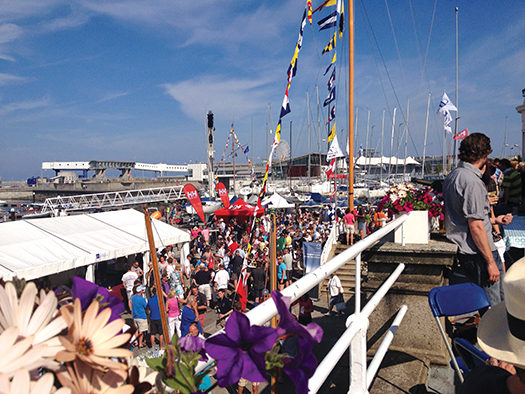
When the summer comes, the après sailing at the VDLR is world class. Photo: VDLR
Further reading:
Download the full entry list for Dun Laoghaire Regatta 2015 class by class below
Download the Sailing Instrcutions for Dun Laoghaire Regatta 2015 HERE
- Dun Laoghaire Regatta
- Volvo Dun Laoghaire Regatta
- Royal St George Yacht Club
- Royal Irish Yacht Club
- National Yacht Club
- ISORA
- Water Wags
- Royal Alfred Yacht Club
- yellowbrick
- GP 14
- Nigel Biggs
- George Sisk
- Annalise Murphy
- Half Tonners
- Tim Goodbody
- Mermaid
- Fool's Gold
- Dragon
- Irish National Sailing School
- Kenneth Rumball
- Dublin Bay
#isora – The Royal Ocean Racing Club (RORC) in London and Dublin's headquartered Irish Sea Offshore Racing Association (ISORA) have joined forces to offer a unique offshore offering to Irish Sea sailors in July.
ISORA boats can look forward to the cache of RORC medallions for their next race across the Irish Sea too!
The Lyver Race from Liverpool on Friday 3rd July forms part of the Offshore Series of the Volvo Dun Laoghaire Regatta and kick starts another intense peiod of offshore racing in the Irish Sea that follows on from May's frustrating but enjoyable Isle of Man offshore weekend and the just finished Dun Laoghaire to Dingle Race.
In effect July's Lyver Race is "four races in one" – Liverpool Yacht Club's Lyver Cup, ISORA Series, RORC Race and the part of the Royal Dee YC Offshore Championship.
RORC medallions will be presented by the Commodore of RORC, Dubliner Michael Boyd, in the National Yacht Club immediately after race results are issued.
The Lyver Race is also part of the inaugural Royal Dee YC 200th Anniversary Offshore Championship that consists of five races – Lyver Race and the four Offshore Series in the VDLR on the following week in Dun Laoghaire.
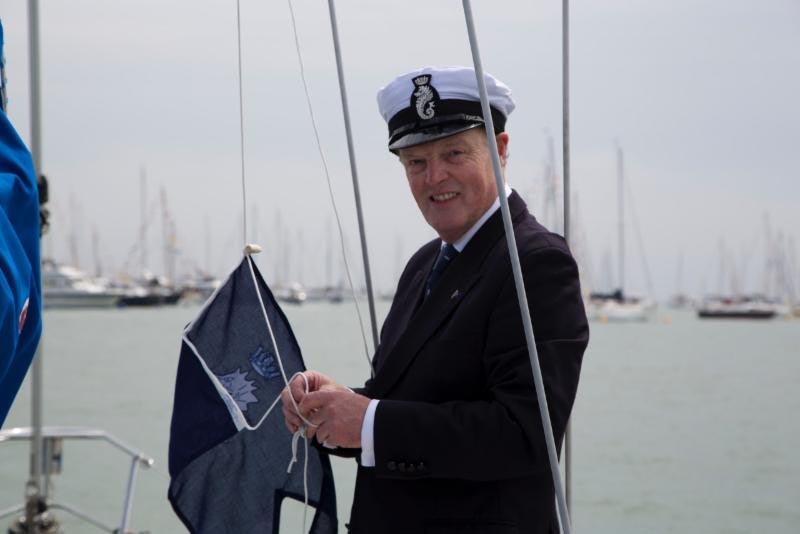
RORC Commodore Michael Boyd
Volvo Dun Laoghaire Regatta 2015 Notice Of Race (NOR) Download Here!
#dlregatta – Volvo Dun Laoghaire regatta Chairman Tim Goodbody has published the Notice of Race for the 2015 edition of Ireland's biggest sailing event. At this early stage, the following events have been confirmed as part of the Volvo Dun Laoghaire Regatta 2015:
• Royal Dee Irish Sea Offshore Challenge
• J109 Irish National
Championship
• RS Elite Irish National
Championship
• Beneteau First 21 Irish
Championship
• Wayfarer Irish National
Championship
• GP 14 Leinster Championship
• J24 Leinster Championship
In the notice of race published in time for November's weekend cruiser conferene in Galway, Goodbody confirms he is following the 'well proven format' of four days of racing commencing on the afternoon of Thursday 9th, and finishing Sunday afternoon 12th July.
The organising committee have taken on board the valuable feed-back from our 2013 regatta and are working hard to ensure an even more successful event for 2015.
The regatta is already in a position announce the continuing sponsorship of Title Sponsors Volvo Car Ireland and Spirit Motor Group, along with many "Premium" sponsors.
Feeder races have been organised from Scotland, Northern Ireland, Wales and the West coast of England, with free berthing for the duration of the regatta.
#vdlr –The Royal Ocean Racing Club's rating office in London has given a ringing endorsement of the dual scoring system employed at Irish regattas and reports of its findings when it visited Ireland's biggest regatta in July. The four clubs in Dun Laoghaire on Dublin Bay jointly hosted the biennial Volvo Dun Laoghaire Regatta for a large fleet including around 120 IRC boats. Emma Smith and Jenny Howells attended the event on behalf of the RORC Rating Office and were able to provide on-site IRC assistance to the organisers, meet owners and crews, and watch some of the racing on the water. It was also interesting to see dual-scoring with ECHO (the Irish national handicap system) in action.
ECHO is a progressive handicapping system, so the ECHO TCC changes after every race to reflect actual performance; this system allows everyone to race together but ensures that the keen racers don't win under both systems. For instance, at this event, the IRC class 2 and overall IRC winner "Checkmate XV" saw her ECHO TCC increase from 1.012 to 1.121 over six races, leaving her 7th overall in ECHO 2. There are clear advantages to club racing of dual scoring between Spinlock IRC and a national or local handicap system which you can read about on the RORC Rating website.
Local Boats Score at Volvo Dun Laoghaire Regatta
#VDLR2013 – Home grown success is being toasted in Dun Laoghaire this evening following the conclusion of Ireland's biggest sailing event, the Volvo Dun Laoghaire regatta on Dublin Bay.
In spite of an influx of over 120 visiting boats, key trophies are staying in the waterfront clubs after this afternoon's prizegiving at the Royal Irish Yacht Club brought the curtain down on the 2013 event. VDLR prizegiving photos here
The Royal St. George YC had success in seven classes, Royal Irish sailors won six, including IRC classes 1 and 3, and the National YC won four one design divisions. Howth picked up two wins in IRC non–spinnaker divisions.
Trophies were awarded in each of the 25 competing classes plus several premier awards.
The top overall prize, for the Volvo Trophy, went to the Class II IRC winner Checkmate XV, a 1985 vintage half tonner that has been extensively refitted.
The Nigel Biggs skippered entry from the Royal St. George Yacht Club, sailed by a group of friends, won all five race in its 26-baot fleet.
In a successful season so far for this Rob Humphrey's design, Biggs now adds the Volvo crown to the national title taken last month in County Kerry.
The 1985–built Humphrey's design has been extensively refitted and optimised for the IRC rule under the guidance of Wicklow based yacht designer Mark Mills.
The boat has been extensively campaigned already this season taking in regattas in Monaco and Marseiiles, before heading to Fenit for the ICRA Nationals in early June.
The Checkmate crew line up includes Pete Eevans, George Rice, Jimmy Houston, Robbie Sargent, Matt Byham, all of whom have either Commodore's Cup or Admiral's Cup experience. The average age on board Checkmate is 43.
The next regatta for the boat is the Half Ton Cup in Bologne.
The biennial regatta is being hailed an enormous success both afloat and ashore. A combined fleet of 393 boats raced over eight courses in a range of light to medium conditions since racing began last Thursday.
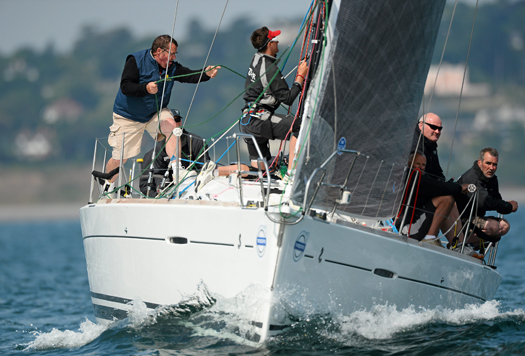
Regular Scottish visitor Steven Cowie's Zephyr competing in Class 0 Photo: David Maher/Sportsfile
In the J109 class, John Maybury's Joker II from the Royal Irish Yacht Club won this morning's final race to overhaul Pat Kelly's Storm and win Volvo honours and the Irish title too by a single point, a fitting climax to one of the toughest fleets in the competition.
Another Royal Irish boat, Bon Exemple, the Xp33 skippered by Colin Byrne, was the winner of IRC one and also received the top IRC boat prize in the regatta. Second in IRC one was Scotland's Now or never 3 with Byrne's club mate Paul O'Higgin's Rockabill V third. Rockabill briefly held the lead after the penultimate day but his O'Higgins' double win was shortlived after a protest for a port and starboard incident in Saturday's first race dropped the Corby 33 down the rankings.
Jean Mitton's Levana from the Royal St. George has been awarded best one design performance of the competition following her win in the 17–boat Beneteau 31.7 fleet, a results that bodes well for next month's national championships on the same race track.
Scottish boats took the honours in IRC Zero with Steven Cowie's Beneteau 40, Zephyr from Royal Gourock beaten overall by Jamie McGarry's Beneteau First 40.7 Grand Cru 2 from Clyde Cruising club. Dun Laoghaire regatta regular, McGarry also picks up the prize for best visiting boat.
In IRC 3, Barry Cunningham's optimised Quarter tonner Quest from the Royal Irish YC broke the stranglehold of six J24s to win the 25-boat fleet, possibly the most competitive class three fleet to date with the J24s tuned for next month's world championships in Howth.
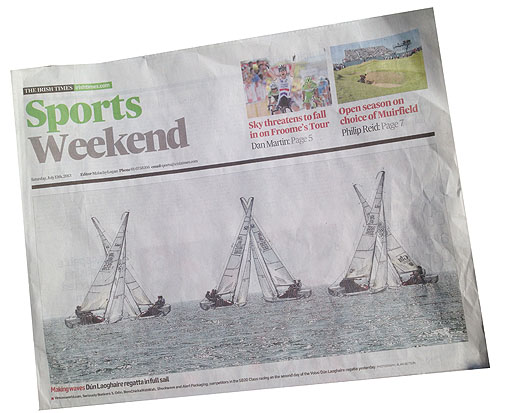
Award winning photographer Alan Betson captured the action for the front of the Irish Times Sports Supplement on Saturday, adding to the strong media coverage for the event. A post regatta feature is due to be broadcast tomorrow morning on RTE1's Morning Ireland radio show.
In the experimental IRC coastal division Arklow Sailing Club's Aquelina (James Tyrrell) was declared the winner in the inaugural 15-boat fleet. Read WM Nixon's account of the first race in this series in his Saturday Sailing Blog: Muglin's Challenge Caper
With five wins in nine races Ian Mathews and Chris Russell of the National YC were clear winners in the Flying fifteen one designs. Michael O'Connor of the Royal St. George won the SB20s and club mates Derek Jago and John O'Rahilly won the Squibs.

Funk Phenomena, sailed by Gavin Doyle and Dave Sweeney, competing in the Fireball Class. Photo: David Maher/ Sportsfile
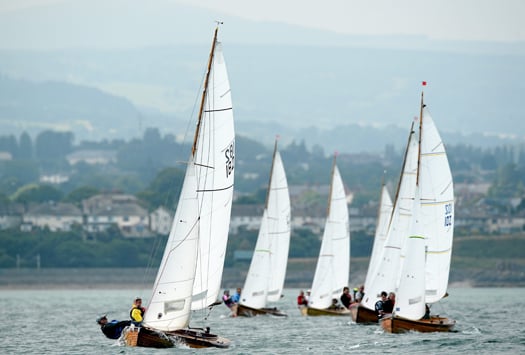
The Mermaid class at VDLR. Photo: David Maher/ Sportsfile
After ten races sailed in the Fireball dinghy class, Bryan Byrne and Steven Campion were two points clear of Conor and James Clancy to win the Volvo prize.
In addition to the 260 local boats that competed in the regatta, 120 came from yachts clubs outside Dublin Bay, Northern Ireland and right across the British Isles, which, organisers say, means a significant boost to the local economy.
The next Dun Laoghaire regatta will be held mid–July 2015.
A breakdown of overall results is below
VDLR 2013 – OVERALL
IRC CLASS 0 1. Grand Cru II (J McGarry) 2. Zephyr (S Cowie) 3. Dark Angel (A Ackland)
IRC CLASS 1 Bon Exemple (X Yachts GB) 2. Now or Never 3 (N Sandford) 3. Rockabill V (P O'Higgins)
IRC CLASS 2 1. Checkmate XV (N Biggs) 2. Scenario Encore (S&J Fitton) 3. Tribal (L Burke)
IRC CLASS 3 1. Quest (Cunningham & Skerritt) 2. Kilcullen Euro Car Parks (Howth YC K25 Team) 3. Nyah (S Hyde)
J109 1. Joker II (J Maybury) 2. Storm II (P Kelly) 3. Jalapeno (Barrington/ Burke/ Phillips)
SIGMA 33 1. White Mischief (T Goodbody) 2. Leaky Roof (A Harper/ E&K Robertson) 3. Rupert (R&P Lovegrove)
BENETEAU 31.7 1. Levana (J Mitton) 2. Prospect (C Johnston) 3. Levante (M Leahy/ J Power)
IRC Coastal 1. Aquelina (S&J Tyrell) 2. Wow (G Sisk) 3. Mermaid IV (S Fitzpatrick)
NON-SPINNAKER 1 1. Bite the Bullet ( C Bermingham) 2. White Lotus (P Tully) 3. Orna (P Dilworth)
NON- SPINNAKER 2 1. Demelza (S Ennis) 2. Vespucci (S&K O'Regan) 3. Nauti-Gal (J&J Crawford)
Ruffian 23 1. Diane 2 (A Claffey/ C Helme) 2. Ruff Nuff (D Mitchell) 3. Bandit (Kirwan/ Cullen/ Brown)
Shipman 1. Curaglas (J Masterson) 2. Gusto (C Heath/ G Mills) 3. Whiterock (H Robinson)
SB20 1. Should Be? (M O'Connor) 2. BomChickaWahWah (J O' Driscoll) 3. Seriously Bonkers 3 (M Cuppage/ P Lee)
RS ELITE 1. Storm (J Gunning/ S Polly/ D Kelso) 2. Momentary Laps... (J Patterson) 3. Toucan (G&M Vaughan)
BENETEAU FIRST 21 1. Chinook (A Bradley/ P Morgan) 2. Yikes (J Conway) 3. Carna (S Spence)
DRAGON 1. Phantom (P Bowring/ D Williams) 2. Jaguar (M Byrne) 3. Diva (R&R Johnson/ R Goodbody)
Flying Fifteen 1. The Gruffalo (I Matthews) 2. Melliffluence (B Mulligan) 3. The Big Bow Wow (N Meagher/ N Matthews)
GLEN 1. Glenluce (R&D O'Connor) 2. Glendun (B Denham) 3. Glenariff (A Lee)
HOWTH 17 1. Isobel (B&C Turvey) 2. Oona (P Courtney) 3. Pauline (S O' Doherty/ E Ryan)
Fireball 1. Let's Get Messy (B Byrne) 2. Tipsey McStagger (C&J Clancy) 3. Goodness Gracious (L McKenna/ F Rowan)
IDRA 14 1. Starfish (A Carr/ D Kilroy) 2. Delos ii (P O'Neill) 3. Slipstream (J Ascoop/ H Keenan)
MERMAID 1. Tiller Girl (J O'Rourke) 2. Jill (P Smith/ P Mangan) 3. Endeavour (R Bannon)
SQUIB 1. Why not (D Jago) 2. Iola (F Whelan) 3. Perfection (J Fleming)
WATER WAG 1. Mollie (C MacAleavey) 2. Swift (G Kilroy) 3. Pansy (V Delaney)
Sail Fleet J80 Bay Challenge 1. More Mischief (E Doyle) 2. Katie (T Dunne/ F Fahy/ C McGuinness/ D Grace) 3. Xerxes (D O'Neill)
PY 1. IRL 171 426 (F Devlin) 2. IRL Return of the Milky Bar Kid (H Sheehy) 3. UG (R O'Leary)
#vdlr2013 – To mark today's opening of the country's biggest sailing regatta, the Irish Times Newspaper has published the full entry list of 393 competing boats on page 25 of this morning's edition. Dublin becomes the heart of Irish Sea yachting today with a bumper fifth edition of Volvo Dun Laoghaire regatta (VDLR) and a combined fleet of 25 racing classes.
What's even more satisfying for organiser Adam Winkelmann is 120 entries are made up of visiting boats. It's a huge achievement for the capital's waters given Scotland's version of Dun Laoghaire week, the Scottish Series, organised by the Clyde Cruising Club in May, struggled with only 80 entries.
The piece features a colour photograph of a spinnaker duel between top Dublin Bay Sigma 33s from last Saturday's Dublin Bay Sailing Club race in which Tim Goodbody's White Mischief from the Royal Irish YC has a narrow lead over Ronnie Moloney's Moonshine of the Royal St. George YC. Both boats are in action again this afternoon in a 12-boat Volvo Dun Laoghaire regatta fleet.
All they need now in this current warm spell is wind, and although this morning Dublin Bay remains a glassy calm, we are reliably informed a 'gentle sea breeze' will get the fleet away at 3pm today.
#dlregatta – Liverpool Yacht Club and Royal Dee Yacht Club will race offshore to Howth on July 5 for The Lyver Trophy race that forms part of the overall ISORA series. The race that attracted a strong Irish entry two years ago is a British feeder race for Volvo Dun Laoghaire Regatta on July 11-14.
An Entry form and Notice of Race for the Lyver trophy 2013 is available to download below.
Four Championships (and a Mega Party) Planned for Dun Laoghaire 2011
A number of classes have already committed to run open championships within the regatta including the Wayfarer UK and Irish Nationals, the J109 Open Championship, the SB3 Open Championship and a return match of the Irish Sea Championship in J80s between Ireland and Wales. The race management team headed up by Con Murphy, aided by the usual ocean of wonderful volunteers, are working to facilitate this to ensure the kind of quality race management and organisation that will ensure the success of these championships.
The non-spinnaker fleet was the largest fleet in the Regatta in 2009 and is expected again to top the numbers and provide great racing for large boats with a smaller crew.
The regatta combines the wonderful waterfront facilities of all 4 Dun Laoghaire clubs and includes support from other clubs in the Dublin area including Howth. There will be a full on entertainment programme for all participants and many more with the continued support of many of the sponsors of 2009 which included Volvo Cars, Dublin Port, Dun Laoghaire Rathdown County Council, The Royal Marine Hotel, Helly Hansen, Dubarry and many more.
One of the highlights of the regatta are the Ladies Lunches which will again be held across a number of the clubs on the Saturday. Top Fashion, great food, a dash of style accompanies by the glass of champagne are the order of the day. All these at a very reasonable price reflecting the realities of today's tightened purse strings.
There will be more announcements in the coming weeks.
For more information visit www.dlregatta.org or event secretary Ciara Dowling at [email protected]































